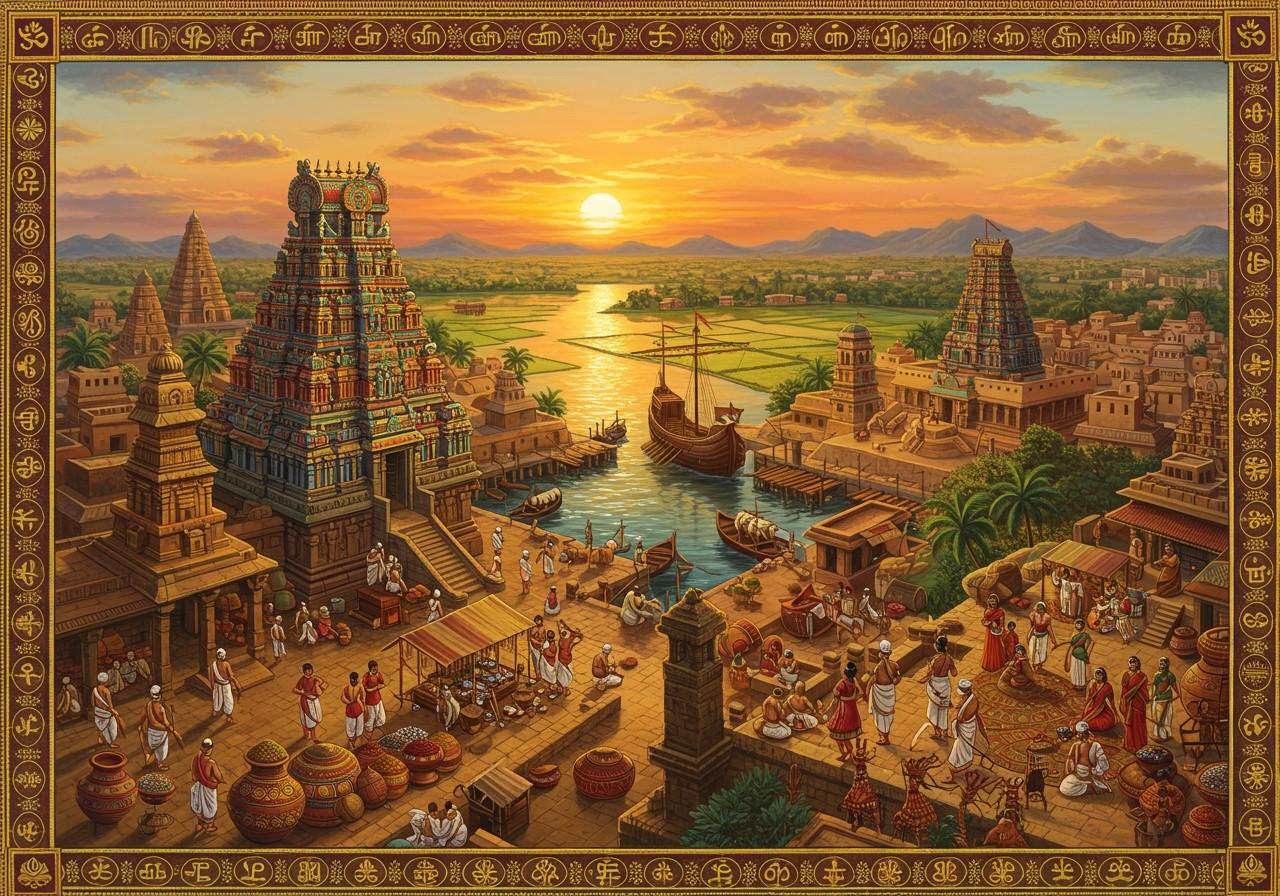
Ancient Tamilakam, also known as the Tamil country, refers to the region inhabited by Tamil people in South India during the classical age. This area includes present-day Tamil Nadu, parts of Kerala, Karnataka, and Andhra Pradesh. The rich history and profound cultural heritage of Tamilakam have deeply influenced South Indian culture and traditions. Ancient Tamil history, primarily known through Sangam literature (a collection of 2,381 poems by 473 poets dating from the pre-Christian era to the early centuries CE), offers valuable insights into the socio-political, economic, and cultural life of the region. Evidence suggests continuous human habitation in Tamil Nadu from 15,000 BCE to 10,000 BCE.
Geographical Overview of Ancient Tamilakam
Boundaries and Natural Landscapes
Tamilakam encompasses present-day Tamil Nadu and parts of Kerala, Karnataka, and Andhra Pradesh. The Western Ghats and Eastern Ghats serve as natural boundaries, while the coastal plains provide fertile land. Major rivers like the Kaveri, Vaigai, and Tamirabarani were essential for agriculture and settlements, supporting the growth of civilizations.
Major Cities and Ports
Prominent cities and ports like Puhar (Kaveripattinam) played vital roles in trade and cultural exchange, connecting Tamilakam with the wider world. The tropical climate influenced agricultural practices and contributed to the region’s biodiversity and ecological significance during the classical age.
Historical Timeline and Key Dynasties
Major Periods
Tamilakam’s history spans the Sangam era (6th century BC to 3rd century CE), the post-Sangam period, and medieval times. The Sangam Age is particularly significant for its contributions to Tamil literature, culture, and political institutions. The Chera, Chola, and Pandya dynasties were instrumental in shaping the region’s history and culture.
Wars and Alliances
Wars and alliances between the Chera, Chola, and Pandya dynasties shaped the political landscape of Tamilakam. Trade with Roman and Southeast Asian civilizations brought significant cultural and economic exchange, leading to notable advancements in art, architecture, and other cultural spheres.
Cultural and Social Structure
Tamil Literature
Tamil literature, including Sangam poetry and classical works like Thirukkural, holds immense cultural importance. These literary works reflect the philosophical, ethical, and social values of ancient Tamil society. Temples and religious practices played a central role in daily life, influencing social structures and traditions.
Festivals and Arts
Festivals, rituals, and traditional arts like dance and music were integral to Tamilakam’s vibrant culture. The education system placed high value on scholars and poets, fostering intellectual growth and artistic expression. Tamilakam’s cultural influence extended to neighboring regions, leaving a lasting impact on South Indian culture.
Economy and Trade
Agricultural Practices
Agricultural practices focused on cultivating crops suited to the tropical climate, ensuring food security and economic stability. Trade routes and port cities like Puhar and Muziris facilitated commerce and cultural exchange with distant lands.
Maritime Trade
Maritime trade with Rome, Greece, and Southeast Asia flourished, bringing prosperity to the region. Commodities like spices, textiles, and precious stones were traded extensively. Economic policies and taxation systems supported trade practices and contributed to the overall economic growth of Tamilakam.
Art and Architecture
Dravidian Architecture
Dravidian architecture, characterized by its intricate temple designs and towering gopurams, is a hallmark of Tamilakam’s artistic legacy. Temples like the Brihadeeswarar Temple and Meenakshi Amman Temple showcase stunning examples of Dravidian architectural style. Sculptures, paintings, and carvings further highlight Tamilakam’s artistic achievements. Temple architecture played a central role in both cultural and religious life.
Poojn.in: Connecting You to Tamil Cultural Heritage
Poojn.in offers a wide selection of authentic Tamil ritual items and puja materials, allowing you to connect with the rich traditions of Ancient Tamilakam. Our collection includes:
- Traditional brass lamps (Kuthu Vilakku) used in Tamil temples and homes, perfect for illuminating your personal sacred space.
- Pure copper vessels for sacred water rituals, essential for traditional ceremonies and practices.
- Authentic vibhuti and kumkum from Tamil Nadu temples, adding a touch of sanctity to your rituals.
- Special puja items for Thai Pongal celebrations, making your festivities more authentic and meaningful.
- Traditional Tamil wedding ceremony items, ensuring a blessed and culturally rich start to your marital journey.
- Handcrafted items from Tamil artisans, supporting local craftsmanship and preserving traditional art forms.
We deliver across India, ensuring easy access to these items regardless of your location. Our quality-checked products include detailed usage instructions in both Tamil and English. Visit Poojn.in or download our mobile app to explore our complete collection. We provide secure packaging and timely delivery for your convenience.
Download the Poojn mobile app to discover our full range of Tamil ritual products.
Conclusion: The Lasting Legacy of Ancient Tamilakam
Ancient Tamilakam’s vibrant history and culture continue to inspire and shape modern South Indian society. Its remarkable literature, grand temples, thriving trade, and agricultural practices have left an enduring impact. The wisdom in classical works like the Thirukkural remains relevant, guiding values and principles today. The architectural marvels, such as the Brihadeeswarar Temple and Meenakshi Amman Temple, stand as testaments to Tamilakam’s artistic and cultural achievements. Exploring Ancient Tamilakam allows us to appreciate its profound influence on South Indian culture.
To learn more about Dravidian architecture and South Indian temples, explore these resources:
- Dravidian and Nagara Architecture: A Comparison of Styles
- Dravidian Temples: A Guide to Their Key Architectural Features
- South Indian Temple Architecture: A Sacred Journey
For those interested in Tamil rituals and cultural items, Poojn.in offers a curated selection:


